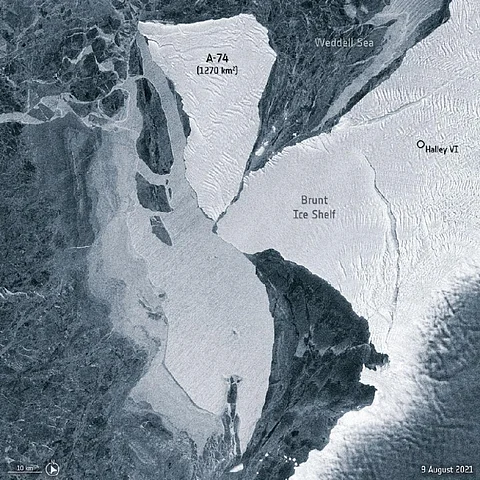

The Brunt Ice Shelf attached to the western tip of Antarctica was saved from a devastating collision with a 1,270-square kilometre iceberg earlier this month, the European Space Agency (ESA) announced last week.
A chunk bigger than the iceberg A-74 would have been knocked off the iceshelf had the impact been stronger, said ESA.
The iceberg broke off Brunt late February this year. Strong ocean currents prevented it from floating westward into the Wendell Sea and it hovered close to the shelf’s west coast for six months.
Strong easterly winds redirected the giant mass of ice in early August. It began to travel southwards, brushing lightly against the western tip of Brunt, as captured by the agency’s Copernicus Sentinel-1 satellite.
A nose-shaped portion of West Brunt, which covers an area of 1,700 sq km, is at the brink of being dislodged from the iceshelf due to a deep, growing chasm (Chasm 1), the satellite image showed.
“If the berg had collided more violently with this piece, it could have accelerated the fracture of the remaining ice bridge, causing it to break away,” said ESA’s Mark Drinkwater.
The portion, however, remained grounded on the seabed and attached to Brunt even after the collision, according to an ESA report.
Breaking of icebergs and the rapid melting of polar ice caps is attributed to global warming of the land and sea. These events result in an unprecedented rise in sea leve and change in ocean currents, according to Samrat Sengupta, programme director, climate change and renewable energy, Centre for Science and Environment, a Delhi-based non-profit.
He added:
Rising sea levels indundate low-lying coastal regions and pose threats to the local communities and the biosphere. The Sundarban delta, the world's largest mangrove biosphere, is experiencing one of a 30 millimetre rise in sea level every year and subsequent, significant land erosion. If not checked, the crisis may turn severe in the near future and also threaten Kolkata.
The 130-metre thick ice shelf is the site of the British Antarctic Society’s Halley VI observatory. The research station was initially located close to Chasm 1 but was moved 20 km east in 2017 as the crack began to widen.